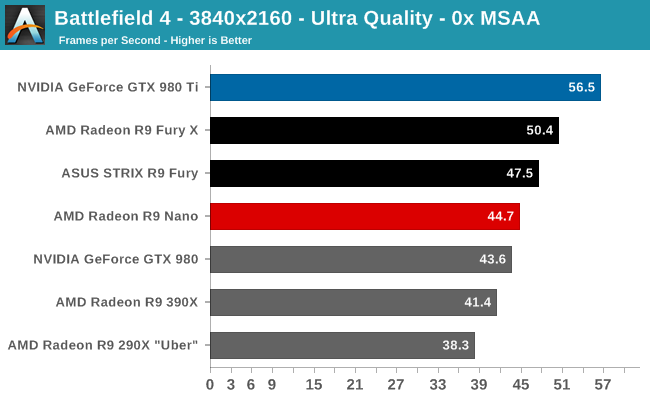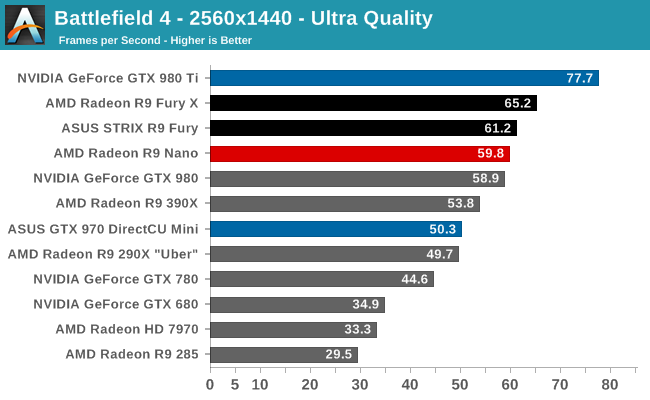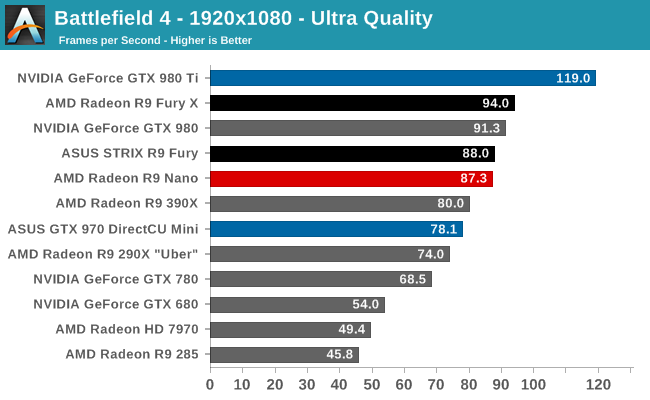The AMD Radeon R9 Nano Review: The Power of Size
by Ryan Smith on September 10, 2015 8:00 AM ESTBattlefield 4
Kicking off our benchmark suite is Battlefield 4, DICE’s 2013 multiplayer military shooter. After a rocky start, Battlefield 4 has since become a challenging game in its own right and a showcase title for low-level graphics APIs. As these benchmarks are from single player mode, based on our experiences our rule of thumb here is that multiplayer framerates will dip to half our single player framerates, which means a card needs to be able to average at least 60fps if it’s to be able to hold up in multiplayer.




Like the other Fiji cards, AMD is promoting the R9 Nano in part on its 4K capabilities. And while we disagree that this card is suitable for 4K gaming based on its sub-Fury performance, we’re including 4K results anyhow to serve as a point of comparison.
In any case Battlefield 4 is often a good indicator of general card performance, and for the R9 Nano this is no exception. What we find is that the R9 Nano trails the other Fury cards in all cases. However to our initial surprise, the R9 Nano sticks rather close to the R9 Fury. The petite powerhouse trails the R9 Fury by only 1-6%, which for the record is a smaller gap than we were expecting.
While the R9 Nano packs a full Fiji GPU, AMD has to pull back on clockspeeds to hit their power targets; in the case of Battlefield 4 this is an average clockspeed of just 879MHz at 2560x1440. Given this we had been expecting the R9 Nano to deliver around 85-90% of the performance of the R9 Fury (and about 80% of the R9 Fury X), based on the assumption that average clockspeeds would be closer to 800MHz. So the fact that the R9 Nano starts off as close to the R9 Fury as it does – even if it’s still trailing it – is a pleasant surprise.
Otherwise with performance still clearly occupying a position as a “3rd tier” Fiji card, I’m not sure if anything about these results should be surprising. On a price/performance basis AMD is not intending to be competitive with other $650 cards, so the R9 Fury X and GTX 980 Ti are of course on the top of the heap. What you get instead is a card that delivers around 90% of R9 Fury X’s performance in BF4 with much less power consumption.
Moving on, compared to the lower power and smaller cards, the R9 Nano is as expected a clean sweep. Demonstrating the virtues of a wide and lower clocked processor’s ability to deliver strong performance without requiring extreme power, everything from the R9 285 to the GTX 980 trails the R9 Nano here. Compared to the GTX 970 Mini in particular, the R9 Nano is 12-26% faster depending on the resolution.
The one potential problem here for the R9 Nano is the GTX 980. Though not a Mini-ITX card, the GTX 980’s power consumption is going to be fairly close to the R9 Nano’s, definitely more so than GTX 970’s. From a power efficiency standpoint it’s the GTX 980 that poses the greatest challenge to the R9 Nano, and while it’s ahead of the GTX 980 in this case at 2560x1440 and higher, it’s a sign that AMD should be worried about what could happen if an NVIDIA partner produced a Mini-ITX GTX 980.










284 Comments
View All Comments
D. Lister - Sunday, September 13, 2015 - link
The Fermi architecture did indeed have those flaws, not to mention the thermal issues of the 4xx family and the strict power budget of the 5xx series that Nvidia stupidly enforced on its partners. The latter resulting in CTD in the factory overclocked models in some poor PC ports like Crysis 2, where the only solution was to downclock the GPU to its reference state. But despite such rare lapses, Nvidia has evolved steadily, and every generation has rectified the flaws of its predecessor, and improved in terms of features, power usage and temps.Oxford Guy - Tuesday, September 15, 2015 - link
Don't forget the driver that bricked Fermi cards.D. Lister - Sunday, September 13, 2015 - link
@medi03Sorry, but that nonsense just doesn't cut it anymore. Not after so many years of the same fraudulent babble going on over and over.
If someone "uneducated" was told that product A and product B both performed the same, yet product A could be bought for less money, than most people would go for product A.
If that is not happening than obviously there is more to this than purely performance/dollar(*), and the market is a lot more educated in the year 2015 than your fanboy delusions would've led you to believe.
Honestly, you AMD fanatics are like the Westboro Baptist Church of technology. I wouldn't be surprised if you lot started picketing outside the Intel and Nvidia HQs with "God hates Intel/Nvidia" placards.
*-Sadly, thanks to that HBM gimmick, AMD doesn't even have the performance/dollar feature anymore. The Nano's MSRP equals the 20-30% stronger 980Ti's retail value, and because of its rarity, actually is more expensive than the 980Ti.
medi03 - Monday, September 14, 2015 - link
I don't recall talking about "performance dollar", why do you have to lie like that? Is that your imagination?There were CLEAR, HANDS DOWN cases of inferiour products, be it nVidia's Fermi chips, or Intel's Prescott P4 fiasco outselling the competitor. That shows how much clue our "uneducated" public has. End of story.
Now take a deep breath and think if you really have some argument.
D. Lister - Monday, September 14, 2015 - link
"I don't recall talking about "performance dollar", why do you have to lie like that? Is that your imagination?"Tsk, tsk, "reading" is obviously not your strong suite.
"There were CLEAR, HANDS DOWN cases of inferiour products, be it nVidia's Fermi chips, or Intel's Prescott P4 fiasco outselling the competitor. That shows how much clue our "uneducated" public has. End of story."
That's your argument? Really? Where can anyone actually even buy Prescotts or Fermis these days? Who is buying them? In those times AMD's market share was significantly higher than it is now and quite rightfully so, rendering your abysmal argument completely moot. And the story didn't end there you silly little man - after Fermi there was Kepler, and then Maxwell. After Prescott there were over a dozen processor families, each and every single one an improvement, not just in raw performance but also in performance/watt and performance/dollar.
Granted that AMD has had improvements as well, but thanks to the terrible decisions of the businessmen at the top (e.g. selling their foundries and getting ATI for a lot more than it was worth, not focusing on their primary markets and losing loyal fans to other companies, etc.), not to mention the terrible software support for often very decent hardware and regularly over-promising and under-delivering, they are where they are now. The facts are ultimately in the ledgers, and mindless corporate drones like yourself can make up absurd stories and conspiracy theories as much as you like - fact is that AMD is dying and as their funds keep shrinking, so does the overall quality of their products, especially compared to the competition.
"Now take a deep breath and think if you really have some argument."
All I can do is shake my head and smile sadly at how completely you miss the irony in your statement. It's okay, once AMD is inevitably ripped apart and its pieces consumed by the corporate sharks and the AMD and Radeon brands are reduced to forgotten footnotes in tech history, cretins like you will find something else to fill the void in your pathetic, pointless existence. Have a nice life, if you can, I'm done with you.
D. Lister - Monday, September 14, 2015 - link
Just to make it very clear (again) to any AMD fans that may feel my sentiments to be overtly harsh towards their favored company, I personally believe that whatever has happened to AMD in the last decade or so, is nothing short of a heart-breaking tragedy, where the business fat cats at the top repeatedly made poor short-term decisions and exploited the hard work of brilliant engineers and technicians, giving themselves and their marketing lackeys bigger paychecks while the R&D starved, resulting in AMD as a company never truly reaching its full potential. And we all, as consumers and enthusiasts are worse off for it.Oxford Guy - Tuesday, September 15, 2015 - link
Too bad for that summary that it ignores the well-made products that AMD's customers have enjoyed and the industry has benefited from.D. Lister - Tuesday, September 15, 2015 - link
@Oxford GuyThat is a given, no? A company that is a complete failure from the start, with everybody under the sun hating their products, can't ever hope to eventually go public, let alone go toe-to-toe, even if for a little while, with an industry giant like Intel.
Unfortunately what AMD did right was rather consistently far outweighed by what they did wrong. For every satisfied customer, they had several that felt screwed over.
AMD is like a race car that has had very good parts, but a lazy pit crew and blind men at the wheel (I resisted the urge of saying "bad drivers", but I'm being too serious here to indulge with lazy puns). So you're reminding me that they pulled a few laps in good time, while I'm lamenting the race that they have nearly lost.
Oxford Guy - Saturday, September 19, 2015 - link
Nice fiction.D. Lister - Sunday, September 20, 2015 - link
lol, thanks. All facts can be reduced to mere fiction when faced with absolute, fanatical denial. But to be fair, yours is hardly the worse, there are still many people who doggedly believe that geocentricism is the truth and all else is lies and fiction.